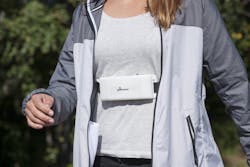The Technology of Airport Security Scanners Helps Guide the Blind
A personal radar system could give a sixth sense to people who already lost one to blindness. Researchers at the VTT Technical Research Centre of Finland are testing wearable scanners that guide the blind or visually impaired by mapping the environment with radio pulses.
Guide Sense, as the technology is called, bounces millimeter waves off objects to measure distance, speed, and where the objects are located in relation to the wearer. The device conveys information to users either with voice feedback or vibrations to indicate how close something is.
The result of a two-year project at VTT, the radar is designed with the same millimeter wave technology used in airport security checkpoints to check underneath people’s clothes for weapons and in radios for transmitting large packets of wireless data between cell towers.
With specialized algorithms, the technology can also be used by security systems for tracking people or imaging tumors in the human body without X-Rays. Northrop Grumman engineers have devised millimeter wave chips for radio astronomy and airplane landing systems.
The high frequencies of millimeter waves enable the radar antennas to be shrunk down and worn, according to Tero Kiuru, a senior scientist at VTT. He said that their system can be strapped around a person’s chest like a heart rate monitor and worn under clothing.
The system is still in the testing and development stage, but early trials have been positive, according to Kiuru. Working with the Finnish Federation of the Visually Impaired, the researchers tested the device on 25 visually impaired people. Of those, 14 were blind, 7 had limited eyesight, and 4 were both partially deaf and blind.
In tests approved by Finland’s National Supervisory Authority for Welfare and Health, the researchers found that 92% of the users reported the GuideSense helped them perceive their surroundings and 32% of users would immediately start using the test device in its current form.
But there are improvements that Kiuru and other researchers are eyeing. For one, the radar has trouble sensing objects like branches and bushes in parks. For another, many of the testers were confused by the vibration-based feedback and imprecision of some distance measurements.
About the Author

James Morra
Senior Editor
James Morra is the senior editor for Electronic Design, covering the semiconductor industry and new technology trends, with a focus on power electronics and power management. He also reports on the business behind electrical engineering, including the electronics supply chain. He joined Electronic Design in 2015 and is based in Chicago, Illinois.

